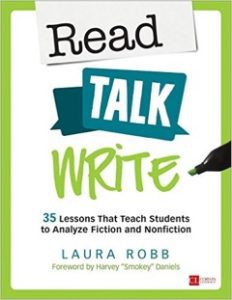I asked Laura to share her thoughts on how an English teacher can create a culture of feedback by supporting student partnership.
Reading and grading papers is a fact of the teaching life. However, writing teachers seem to spend more time on students’ work because they provide students with lengthy revision suggestions and correct most of the students’ incorrect use of conventions. Frustrations over workload and time spent grading quickly set in, but these feelings go underground when you organize writing partnerships in your classes.
Students can select writing partners or you can assign them. However, offering students choice motivates them to work hard and support each other through the process. Since partnerships can change after completing a writing unit, students will be able to pair-up with several classmates during the year. In addition, if a partner is working diligently on a draft, encourage students to seek assistance from someone who has completed that part of the process.
Writing partnerships benefit teachers and students, and the suggestions that follow provide tips that help you place the responsibility for writing plans, drafting, revising, and editing on students.
Supporting Student Partnerships. Collaborate with students and motivate them to write, and at the same time, you’ll boost their engagement in the entire process.
- Create the rubric with student input so that they invest in the process.
- Negotiate with students the amount of time they need for each of the following parts of the process: designing a rubric with you; brainstorming and planning; composing the first draft; revising for content and style; and editing for conventions.
- Circulate among students when they brainstorm, plan, and the draft so you can discuss questions and roadblocks with them and offer suggestions that move them forward.
- Read and offer feedback on second drafts, for these have been greatly improved by students.
- Use the rubric to make positive comments on a sticky note and ask one to two questions that push students back into the revision and/or editing process.
Releasing Responsibility to Students Partnerships. Students learn how to evaluate a piece of writing by comparing it to a rubric. Have students write self and peer evaluations on notebook paper and file these in their writing folders. Make sure students save all of their written work–from brainstormed ideas to second drafts–in a writing folder.
- Have students discuss their topics before brainstorming. This ensures that they generate more detailed lists.
- Ask students to use their rubric to evaluate the richness of details in their writing plan and add specific details when necessary.
- Have students use the rubric to self-and-peer evaluate first drafts by measuring these against the negotiated rubric.
- Help partners understand that first drafts require much work. Encourage them to revise for content first, then writing style, and finally for conventions.
- Have students use their revisions and edits to compose the second draft.
- Require that students turn in all of their work with the second draft on top.
The Payoffs
Teachers find it easier to grade and offer feedback on improved second drafts. Moreover, student partnerships free-up teachers with the time they need to support individuals who struggle with a task.
Partnerships foster independence in writing among students. When they experience how comparing a draft to the rubric provides them with suggestions for improving their piece, they can choose and use feedback to revise and rewrite their writing.

![]()













